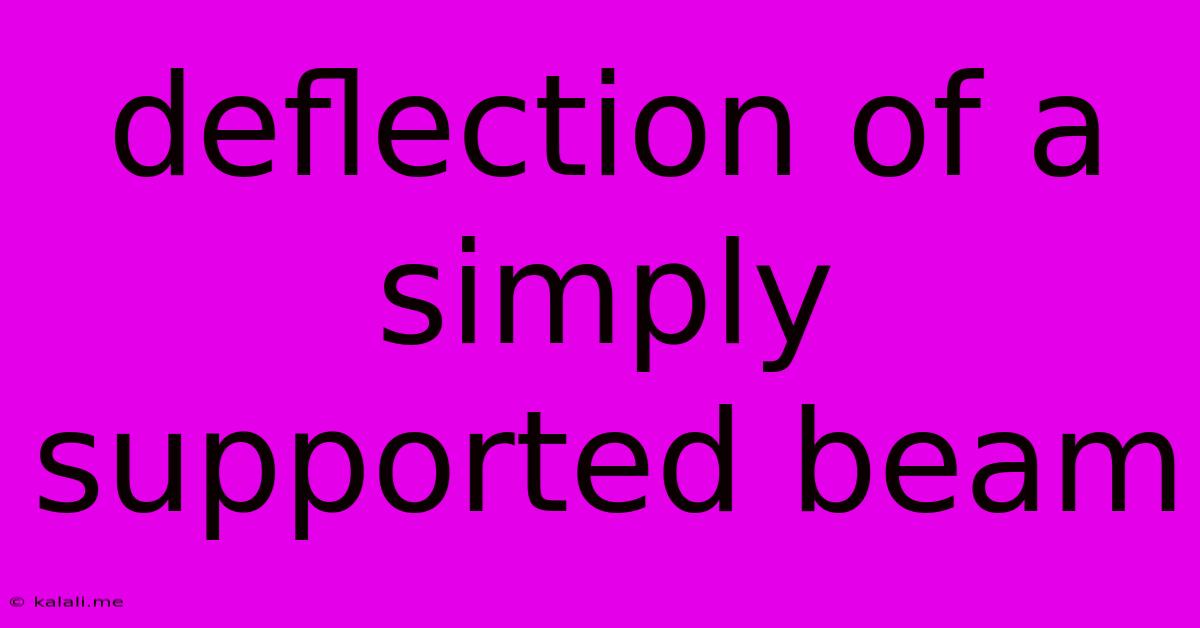Deflection Of A Simply Supported Beam
Kalali
Jun 14, 2025 · 4 min read

Table of Contents
Deflection of a Simply Supported Beam: A Comprehensive Guide
Meta Description: This article provides a comprehensive guide to understanding beam deflection in simply supported beams, covering key concepts, calculation methods, and practical applications. Learn about different load types and their impact on deflection, along with ways to minimize it.
Understanding beam deflection is crucial in structural engineering. A simply supported beam, characterized by supports at each end allowing for free rotation, is a fundamental structural element. This article delves into the mechanics of deflection in simply supported beams under various loading conditions, exploring calculation methods and practical implications.
What is Beam Deflection?
Beam deflection refers to the displacement of a beam from its original, unloaded position when subjected to an external load. This bending is caused by the internal stresses within the beam material. Excessive deflection can compromise the structural integrity and functionality of a beam, potentially leading to failure. Therefore, accurate prediction and control of deflection are paramount in structural design. Factors influencing deflection include the beam's material properties (Young's modulus and moment of inertia), length, cross-sectional shape, and the type and magnitude of the applied load.
Types of Loads on Simply Supported Beams
Several load types can affect a simply supported beam, each resulting in a unique deflection pattern:
- Point Load (Concentrated Load): A single load applied at a specific point along the beam.
- Uniformly Distributed Load (UDL): A load distributed evenly across the entire length of the beam. This is often used to represent the weight of the beam itself or a uniformly distributed surface load.
- Uniformly Varying Load (UVL): A load that increases or decreases linearly along the beam's length.
- Moment Load: A load applied as a bending moment at a specific point on the beam. This could be due to an applied couple or due to an overhang.
Calculating Deflection: Methods and Equations
Several methods exist for calculating beam deflection, ranging from simple formulas to advanced numerical techniques. Common approaches for simply supported beams include:
- Double Integration Method: This method involves integrating the bending moment equation twice to obtain the deflection equation. It's a powerful technique applicable to various load conditions. This requires knowledge of calculus.
- Macaulay's Method: A modification of the double integration method, particularly useful when dealing with multiple point loads or varying load conditions. This simplifies handling discontinuous load functions.
- Superposition Method: This method allows combining the deflection equations for individual loads acting on the beam. It's particularly useful for complex loading scenarios where the beam is subjected to multiple load types. It relies on the principle of linear elasticity.
- Using Beam Deflection Tables: Pre-calculated deflection formulas are available for standard load cases on simply supported beams, simplifying calculations. These tables are readily available in structural engineering handbooks and online resources.
Specific equations for deflection vary based on the load type. For instance, the maximum deflection for a simply supported beam with a central point load (P) and length (L) is given by:
δ<sub>max</sub> = (PL³)/(48EI)
where:
- δ<sub>max</sub> is the maximum deflection
- P is the point load
- L is the beam length
- E is the Young's modulus of the beam material
- I is the moment of inertia of the beam's cross-section
Similar equations exist for UDL, UVL and other load types.
Minimizing Beam Deflection
Several strategies can help minimize beam deflection:
- Increase Beam Stiffness: Using a material with higher Young's modulus (E) or increasing the moment of inertia (I) by altering the beam's cross-section (e.g., using a wider or deeper beam).
- Reduce Span Length: Shortening the beam's length (L) significantly reduces deflection.
- Add Intermediate Supports: Introducing additional supports along the beam divides the span, reducing the maximum deflection.
- Optimize Load Distribution: Careful planning of load placement can help minimize bending moments and thus deflection.
Conclusion
Understanding and controlling beam deflection is critical for ensuring the structural stability and serviceability of structures. This article has provided a foundational understanding of beam deflection in simply supported beams, covering various load types, calculation methods, and strategies for minimization. Further exploration of advanced analysis techniques and design considerations is recommended for practical applications in structural engineering. Remember to always consult relevant building codes and engineering standards for specific design requirements.
Latest Posts
Latest Posts
-
Difference Between An Estuary And A Delta
Jun 15, 2025
-
The Coordinates Of A Moving Particle
Jun 15, 2025
-
Parts Of A Spark Plug Diagram
Jun 15, 2025
-
Which Statements Are True Regarding Glycolipids
Jun 15, 2025
-
What Is The Cube Root Of 81
Jun 15, 2025
Related Post
Thank you for visiting our website which covers about Deflection Of A Simply Supported Beam . We hope the information provided has been useful to you. Feel free to contact us if you have any questions or need further assistance. See you next time and don't miss to bookmark.